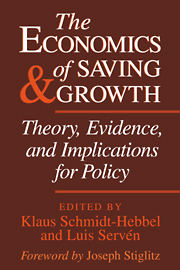2 - Saving in the World: The Stylized Facts
Published online by Cambridge University Press: 18 December 2009
Summary
Introduction
The introduction to this book started with the empirical observation that the world saving rate has declined steadily since the 1960s. Increasing regional disparities are hidden behind this world trend. First, the gap between industrial-country and developing-country saving rates has widened. And within the developing world, the saving divergence across regions has grown massively. At one extreme, national saving ratios have risen from 18.3 percent of GNP during 1965–73 to 27.6 percent during 1984–93 in East Asia and the Pacific (without China), and from 25.3 percent to 36.8 percent in China. At the other extreme, saving rates have been declining steadily in sub-Saharan Africa from 10.5 percent of GNP in 1965–73 to 6.4 percent in 1984–93.
These startling trends warrant a closer look at world saving patterns and their relation to other key economic variables. In this chapter we review six stylized facts concerning the evolution of saving rates in the world and its major regions since the mid-1960s. In addition, possible explanations for the stylized facts offered by recent economic theory are briefly mentioned, anticipating some of the issues taken up in depth in subsequent chapters of this book. This chapter concludes with a brief reference to the causal interpretations of the empirical facts.
An important caution concerns the measurement of saving rates. The data used here suffer from most of the shortcomings of conventional macroeconomic data on saving and related variables.
- Type
- Chapter
- Information
- The Economics of Saving and GrowthTheory, Evidence, and Implications for Policy, pp. 6 - 32Publisher: Cambridge University PressPrint publication year: 1999
- 1
- Cited by



